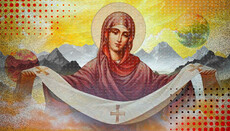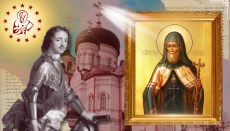Five Convert Saints

The Church has a rich history of saintly converts.
By God’s grace, the Orthodox Church is being flooded with inquirers.
Catechism classes are filling church halls. Some parishes are receiving over a hundred converts every Pascha!
In order to help these new Orthodox Christians live out their baptismal vows, here are five converts to Orthodoxy who were raised to the altar as saints.
Saint Romanos the Melodist (Judaism)
Of course, Christ’s first followers all belonged to the Jewish people. After the second century, however, it became less common for Jewish people to accept Christ as the long-awaited Messiah. One notable exception is Saint Romanos the Melodist.
Romanos was born to a Jewish family in the 400s ikn Syria. Following his conversion, he was ordained a deacon in Beirut and eventually moved to Constantinople. While attached to the Church of Saint Mary of Blachernae. He was favored by the Patriarch of Constantinople for his goodness and humility; however, he was considered a very poor reader. Once, during the All-Night Vigil for the Feast of the Nativity fo Christ, he was assigned to chant the kathismas; Romanos did such a bad job that he was asked to stop, and another cleric took over for him.
That night, the Mother of God appeared to Romanos in a dream. She gave him a scroll and asked him to eat it. The next morning—Christmas Day—Romanos entered the Church, ascended the amvon, and began to chant his famous Kontakion on the Nativity (“Today the Virgin gives birth…”). He chanted with such a beautiful voice that the Patriarch immediately recognized that a miracle had taken place.
It is said that Romanos wrote over 1,000 hymns during the final years of his life. Sadly, fewer than 100 have survived.
The Church commemorates Saint Romanos the Melodist on October 1.
Saint Nikephoros the Solitary (Roman Catholicism)
Little is known about the early life of Saint Nikephoros, except that he was born in Italy in the late 1200s. Though raised a Roman Catholic, he traveled to the Byzantine Empire and converted to Orthodoxy. Eventually, he became a monk of the Mount Athos. It was there that he wrote his treatise “On Watchfulness,” which was collected in the Philokalia. He also served was the spiritual father of a fellow Athonite monk: Saint Gregory Palamas.
Nikephoros was an outspoken opponent of the Council of Lyons. He was arrested in 1275 for opposing the False Union pursued by the Emperor and the Pope. Upon his release, he retreated into the “most isolated parts” of the Holy Mountain. He died peacefully in the early 14th century. He is best remembered for his treatise on nepsis, which is generally believed to be the first written account of the psychosomatic method of hesychasm.
The church commemorates Saint Nikephoros the Monk on May 1.
Saint Alexander the Dervish (Islam)
Technically, Saint Alexander was not a convert: he was born into an Orthodox family in Thessaloniki. However, as a young man, Alexander converted to Islam. Alexander made the hajj (or pilgrimage) to Mecca and joined a Sufi order (hence his title, “the Dervish”).
Unfortunately, this was not terribly uncommon. The Ottoman Empire treated Christians as third-class citizens and lavishly rewarded those who abandoned Christ for Mohammed. However, the overwhelming majority of Christians persevered in the Faith.
Alexander was deeply moved to see Christians bravely suffering under the Ottoman yoke. He pleaded with the authorities to treat the Christians more humanely. This angered the Muslims, who once attempted to assassinate him.
Alexander began to attend the Divine Liturgy—still dressed in the habit of a dervish. Eventually he requested an audience with the local mullah (or judge), declaring:
Mullah! I was an Orthodox Christian and because of my foolishness, I denied my faith and became a Muslim. Later I realized my former faith was light, which I lost, while your faith, as I have come to know it, is darkness. So I have come before you to confess I have made a mistake by denying the light and accepting the darkness. I was born an Orthodox Christian! I want to die an Orthodox Christian! Behold, you have heard my decision, Mullah. Now do to me whatever you wish, for I am ready to endure every torture and to even spill my blood for the love of my Jesus Christ, whom I wrongly denied.
Alexander was imprisoned. The Muslims tried bribery, threats, and flattery to win him back—but to no avail. In 1795, Alexander was martyred by decapitation.
The Church commemorates Saint Alexander the Dervish on May 26.
Maxim of Gorlice (Eastern Catholicism)
Maxim Sandovich was born in 1888 in the Austro-Hungarian Empire. His family were Carpatho-Russians and members of the Ruthenian Greek Catholic Church. As a young man, he traveled to Russia and converted to Orthodoxy.
At the time, many Ruthenians were abandoning the Uniate Church and joining the Orthodox Church. The Catholic government considered this a crime—the crime of “Russophilia.” Orthodox churches were routinely seized by the Uniates, with help from the government. Orthodox priests were beaten, tortured, and killed.
Nevertheless, Maxim eventually returned to his homeland, where he ministered to his fellow converts. Eventually he was arrested by the Austro-Hungarian government. He was executed by firing squad, in front of his mother and father. His dying words were, “Long live Holy Orthodoxy!”
The Church commemorates Saint Maxim of Gorlice on August 6.
Elizabeth the New Martyr (Protestantism)
Saint Elizabeth was born to the Royal House of Hesse in 1864. Her family was Lutheran; in fact, she was a direct descendant of Philip I, Landgrave of Hesse: the most important of the German Protestant princes. Elizabeth spurred advances from German noblemen, having fallen in love with Grand Duke Sergei of Russia. They were married in June 1884.
After they were married, Elizabeth fell in love with Orthodoxy. She chose to enter the Church in 1891. The Romanovs—including Tsar Alexander III—were delighted. The House of Hesse, however, was not. In a letter to her family, Elizabeth explained: “I am sure God’s blessing will accompany my act which I do with such fervent belief, with the feeling that I may become a better Christian and be one step nearer to God.”
Her family accused her of being swept up in the grand rituals of Orthodoxy. She staunchly denied this: “You tell me that the outer brilliance of the church charmed me,” she wrote. “In that you are mistaken--nothing in the outer signs attracted me—no—the service, the service, the outer signs are only to remind us of the inner things.”
In 1905, Grand Duke Sergei was assassinated by communists. Elizabeth sold all of her possessions and received the monastic tonsure. She founded a convent devoted to serving the poor.
In 1918, Elizabeth was arrested by the Bolsheviks along with several other Russian nobles. They were brought to an abandoned mineshaft into which the Communists threw grenades. The Bolsheviks reported that Elizabeth and her companions died singing hymns. When their remains were disinterred, it was discovered that Elizabeth had collapsed while attempting to bandage the wounds of Prince John Konstantinovich.
The Church commemorates Saint Elizabeth on July 5.
BONUS: Blessed Seraphim of Platina (New Age)
Eugene Dennis Rose was born in San Diego, California, in 1934 to a Methodist family. He declared himself an atheist at 14 but remained deeply fascinated by religion. He was something of a beatnik and studied under the New Age icon Alan Watts. A hard-working scholar with a gift for languages, Rose completed graduate studies in Chinese philosophy. He also developed an interest in the “Traditionalist School” of Rene Guenon.
Eventually, Rose found his home in the Orthodox Church. The local ordinary, Archbishop John of San Francisco—the future Saint John Maximovich—quickly recognized that Rose was an earnest struggler. In 1968, Rose was tonsured a monk, being given the name Seraphim. He and another monk founded the Saint Herman of Alaska Monastery in Platina, California.
Father Seraphim came to be known as something of an “anti-guru.” In an age of great spiritual restlessness—the 1960s—he helped many of his fellow seekers to avoid the pitfalls of New Age spirituality and embrace Orthodox Christianity. He is best known for his great asceticism, the purity of his faith, and his many posthumous miracles. His book Orthodoxy and the Future of Religion is considered one of the most important Orthodox works of the 20th century.
Blessed Seraphim of Platina has not yet been raised to the altars. Per tradition, however, his devotees honor him on the day of his repose: September 2.









